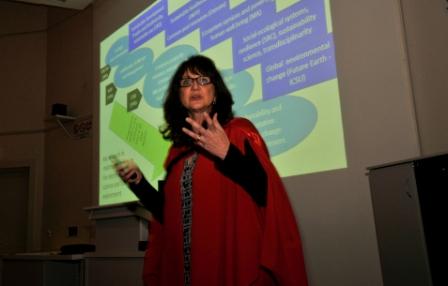
Climate change is real, but its impacts cannot be measured in isolation. In her Inaugural Lecture, Professor Sheona Shackleton of the Department of Environmental Science looked at the links between livelihoods, vulnerability, ecosystem services and climate change.
Professor Shackleton has been working in this arena for most of her academic career. In the past few years she has been doing a lot more applied research around climate change adaptation, which she describes as interdisciplinary, challenging and exciting.
Natural resource-dependent livelihoods are becoming increasingly insecure. Researchers are seeing increasing levels of uncertainty and vulnerability as a result of multiple interacting stressors, among them demographic trends, globalisation, HIV/Aids and climate change.
She explained that her research looks for ways of combating these stressors, and outlined its theoretical underpinnings and framings, which fall under the blanket of Sustainability Science and Political Ecology.
Ecosystem services are the benefits people get from the natural world. These include provisioning services, supporting services and cultural and regulating services such as carbon sequestration.
Vulnerability as a concept has three dimensions: the degree of external exposure to risk or harm, the capacity to respond, and sensitivity or predisposition to the stressor. Professor Shackleton’s research looks at who is vulnerable and to what, how the stressors interact and what their impacts are on society and local livelihoods.
Additionally, vulnerability is recognised as a relational condition rather than a fixed state – she emphasises that context matters when thinking about vulnerability, and people should not be seen only as helpless victims.
The processes people develop to cope with or adapt to the changes, and to reduce the adverse effects on their lifestyles, can be divided into short-term coping, longer term adaption or transformatory change, such as migrations.
Professor Shackleton’s long-term IDRC funded research project looks at the Eastern Cape settlements of Lesseytown and Willowvale. Increasing covariate risk is expected with climate change and already people are anecdotally acknowledging the changes in climate.
Her research also threw up other vulnerabilities: HIV/Aids impacts were accumulating, land under subsistence crops was falling, there was greater crime and increased climate unpredictability, and as a result more ready cash for food was needed.
The respondents, when asked what made them vulnerable in their own communities, highlighted the lack of education, unemployment (for the men) and poverty (for the women), distance to clinics, crime, household dynamics and lack of parental care and guidance for children, HIV/AIDs, infidelity drugs and alcohol and, of course, climate instability.
The main environmental factor highlighted by men was water, and by women, drought. The decline in farming was seen by the men as increasing their vulnerability. Almost a quarter of houses in the project were caring for AIDS orphans and half of the households were affected by the disease.
The most vulnerable tend to fall back on natural resources as a safety net – wild harvested products for food and fuel, and the selling of harvested products. Poorer households use provisioning services to cope.
What transformations, Professor Shackleton asked, are needed to prevent increasing vulnerability and to support adaption and resilience, and who decides on these future trajectories? How can we ensure the voices of the vulnerable are not drowned out? One answer is by building adaptive capacity at local level through learning approaches, and by seeing adaption, poverty alleviation and development as linked transformational processes.
By Jeannie Mckeown
Photo by: Mathieu Dasnois
